ERS-1/2 and Sentinel-1 SAR Data Mining for Flood Hazard and Risk Assessment in Lima, Peru
Abstract
1. Introduction
2. Materials and Methods
2.1. Study Area and Susceptibility to Flooding
2.2. Synthetic Aperture Radar (SAR) Data Mining
- Processing of SAR satellite data and change detection products for image pairs.
- Creation of a project catalogue (database).
- Creation of the spatial analysis project on a GIS platform.
2.2.1. Selection of SAR Data
2.2.2. SAR Data Pre-Processing
- “Apply orbit file”: The orbit file (automatically downloaded by SNAP) provides an accurate position of the SAR image, and the updating of the original metadata of the SAR product.
- “Radiometric Calibrate”: Calibration allows the creation of a SAR image where the value of each pixel is directly related to the radar backscatter of the surface, expressed in decibel (dB).
- “Multilooking”: A characteristic of SAR images is the speckle, i.e., random noise that looks like a “salt and pepper” effect across the image, and affects the quality of the image, thus making SAR data interpretation more difficult. To remove such an effect, it is possible to use speckle filters or, alternatively, to multilook the image. A speckle filter is a compromise between speckle removal (radiometric resolution) and fine details preservation (spatial resolution). For Sentinel-1 images we applied “Multilooking” with 2 looks in azimuth by 2 looks in range [64]. For the ERS-1/2 images we applied “Speckle Filtering” using a Lee filter, which was selected among the possible filters to use according to the recommendations in [65], given that Lee filters are less degrading for the SAR image.
- “Terrain Correction”: We converted the data from slant range geometry to the map geometry (UTM/WGS84 map projection) and corrected the main geometric distortions like layover, shadow and foreshortening, due to terrain relief, using the 3 arcsec Shuttle Radar Topography Mission (SRTM) [66] digital elevation model (DEM), as per the standard workflow of the SNAP software.
2.2.3. SAR Amplitude Change Detection
- “Coregistration stack”: which allows to overlay two images (input), i.e., the reference (master) and the secondary (slave), in order to ensure a perfect match between the pixels of the slave onto the geometry of the master reaching sub-pixel accuracy and, at the same time, preserving the original information contained in the slave [71].
- “RGB Composite”: a multi-channel image generation, allowing for an immediate visualization of the changes in radar backscatter that occurred on the ground during the analysis period between the master and one or more slaves. Each of the R (red), G (green) or B (blue) channels (RGB) is allocated to either the master or the coregistered slave according to a specific combination of colors, thus obtaining a composite image where the different colors highlight different features. The assignment of the three RGB colors to the bands can be freely chosen. For this study, the assigned color scheme was as follows: R = master; G = slave; B = slave. When the slave is the same in both G and B channels, the RGB is actually a red-cyan (RC) composite. This choice allowed us to identify the changes due to the decrease in the backscatter signal in red (Figure 5a), while the changes due to the increase in the backscatter signal in cyan (Figure 5c).
- “Ratio”: through a subtraction operation between bands of the slave image and the master image (values in both expressed in dB; see Section 2.2.2), the ratio map highlights any areas where changes in the backscatter radar occurred. The output of this operation is in grayscale, which, however, can be replaced by a freely chosen combination of colors for better viewing. The decrease or increase of the backscatter signal is displayed with dark colors (Figure 5b) and light colors (Figure 5d), respectively.
2.2.4. Ancillary Data
- Terrain slope: this is a physical environment factor that contributes to the geological hazard as the predisposition of the territory to being flooded during a flood event depending on its elevation vs. the inundation depth. Initially, given that SRTM was used for the terrain correction of the SAR data (see Section 2.2.2), both versions of the same dataset, i.e., SRTM 1 arc-second (30 m) and 3 arc-seconds (90 m), were tested. However, they were replaced with the ASTER GDEM, given the evidence that the SRTM products were affected by gaps in some areas of the Rímac River basin and, as such, they were discontinuous and lacking information. Using the ASTER GDEM, instead, a raster was obtained, with slope values β ranging between 0° and 89°, and subsequently reclassified according to the following classes defined by 5-degree wide intervals: A: β ≤ 5°, B: 5° < β ≤ 10°, C: 10° < β ≤ 15°, D: 15° < β ≤ 20°, E: β > 20°, and finally vectorized. Class A, in particular, includes the alluvial terraces as per the classification in [82]. Alongside terrain slope, the ASTER GDEM has been used to characterize the (geo-)morphology and topography of the areas of interest, and to derive a comprehensive understanding of the physical characteristics that may make those areas prone to flooding, as per the standard practice in flood-risk research (e.g., [83,84]). This analysis has been embedded in the interpretation process of the observed change patterns (see Section 2.3).
- Alluvial deposits: the material deposited or cemented into the lithological unit filling the fluvial valley is the geological factor that testifies a historical predisposition of the territory to alluvial events. The extent of alluvial deposits marks the lowlands of Lima and areas at the highest hazard for inundation.
- Land cover: anthropogenic factor that indicates the spatial distribution and extent of the elements (e.g., houses, infrastructure) potentially exposed to risk. For this study, this layer mostly matches with the extent of the built-up areas and it was compiled by combining the information available through the Open Street Map (OSM) accessed from the QGIS service and the Global Urban Footprint (GUF) produced by the German Aerospace Center (DLR) with TerraSAR-X data [74,75]. Because these two datasets were updated until 2011, the OSM-GUF raster was complemented with new urban areas built between 2011 and 2019 that were digitized from Google Earth imagery.
2.3. Hazard and Risk Analysis
3. Results
3.1. Flooding
3.1.1. Flooded Areas
3.1.2. Riverbed Flooded by Increased Water Flow
3.1.3. Riverbank Collapses and Damage
3.2. No Flooding
- Changes due to anthropogenic factors falling within the categories NF1, NF3, and NF13, were all considered because of their spatial position with respect to the hazard factors (natural, geological and anthropogenic) that could suggest a potential impact on increasing the risk locally;
- Of the changes falling within the categories NF2, NF7, NF9, and NF12, we considered only those located in areas that were very likely to be affected by any future flooding events, given the local slope or because of their proximity to the Rímac River;
- In contrast, categories NF4, NF5, NF6, NF8, NF10, and NF11, were not taken into consideration since they were changes not relevant for the hydraulic risk zoning.
- Motorway construction: the 37 radar backscatter changes corresponding to the construction of the New Central Highway (NAC), show both increases and decreases in the radar signal, due to the movement of machinery, workers, landscaping, among others, thus resulting in a non-homogeneous signal backscatter (Figure 14). These changes are located on alluvial deposits, with slopes in A and B-class (23 and 14 changes, respectively), and in non-urbanized areas.
- Vegetation cover–cropland changes: there are 18 changes, located in non-urban areas and on alluvial deposits, and with A-class slope (β ≤ 5°), due to growing crops or land use changes, e.g., transition to new residential/commercial buildings (Figure 15).
- Ephemeral changes: increase in the radar backscatter was observed in 15 areas as a consequence of an increase in the number of vehicles parked (Figure 16). These changes are located on a slope between A and B-class, on alluvial deposits, with eight changes on non-urbanized areas, and the other seven on urban areas.
- New building constructions: these five changes are considered important for risk assessment, since they have a low slope (A-class), and in conjunction with their proximity to the river, they match with elements that can be easily flooded. They are located on alluvial deposits, and in urban areas (Figure 16).
- Archeological excavations: four changes in the radar backscatter show decrease in the signal in areas with archaeological remains. In one case, the decrease in the backscatter signal could be influenced by the decrease in vegetation in the archaeological area due to a fire (Figure 17). These changes are located on alluvial deposits, on a non-urban area with an A-class slope.
3.3. Zoning of Areas at Risk in Case of Events of Equal Severity
4. Discussion
- The quality of archive satellite imagery available for the area was uneven. In addition to the ERS-1/2 scenes used for the analysis (see Section 2.2.1), 29 more ERS-1 images were downloaded from the EOLi-SA catalogue and pre-processed but, in the end, they could not be used due to issues affecting the raw data and their geolocation (due to Doppler Centroid values >2000 Hz), as reported by ESA’s EO Help team. These images were not included in the input dataset catalogue, and therefore the amount of archive data that could be incorporated in the change detection analysis was reduced.
- Information gaps (missing values) were found in the DEM obtained by the Shuttle Radar Topography Mission (SRTM; see Section 2.2.4). For the case of Lima, data from the ASTER Global DEM (GDEM v.2) was used to address this problem. Alternatively, to remedy the lack of information in the SRTM DEM, measurements taken directly in the field in areas of uncertainty, or by interpolation of level curves, could have been used, but this was outside the scope of the present research.
- The lack of ancillary information with which to carry out a complete analysis. Specifically, the absence of updated information on urban land cover was a limit that had to be overcome at the beginning of this research by creating an ad hoc spatial layer through the union of data from the Global Urban Footprint (GUF) and manual digitization of new urban areas, the latter based on very high-resolution optical satellite images accessed through the basemap service of QGIS and Google Earth.
- The nominal revisit time of the SAR satellites used for this study, i.e., 35 days for the ERS-1/2 and 12 days for the Sentinel-1 (because since October 2016 the area is surveyed by Sentinel-1B satellite only, according to the constellation observation scenario currently operating [63]), which did not allow for acquiring data on the specific days when the flood events occurred, or with shorter site revisits. However, the multi-temporal approach based on multiple pre-, cross- and post-event SAR pairs has increased the possibility of identifying changes relevant to the analysis.
- Both natural and anthropogenic changes have been identified in the SAR images used for this study. Therefore, an expert-led interpretation operation was needed to correctly classify the observed changes into the different categories of “Flooding” (F) and “No Flooding” (NF) and, therefore, to identify the occurred variations in the urban fabric that had some relevance for the purposes of flood risk zoning.
5. Conclusions
Author Contributions
Funding
Acknowledgments
Conflicts of Interest
Appendix A
| Track | Pre-Event | Cross-Event | Post-Event |
|---|---|---|---|
| 218 | - | 10/04/1996–20/05/1998 | 20/05/1998–29/07/1998 |
| 397 | - | 22/04/1996–01/06/1998 | 01/06/1998–19/10/1998 |
| 447 | - | 26/04/1996–01/05/1998 | 01/05/1998–14/08/1998 |
| 125 | 03/04/1996–15/10/1997 | 15/10/1997–22/07/1998 | 22/07/1998–26/08/1998 |
| Relative Orbit | Pre-Event | Cross-Event | Post-Event |
|---|---|---|---|
| 18 | 30/11/2016–24/12/2016 | 24/12/2016–17/01/2017 | 17/01/2017–10/02/2017 |
| 24/12/2016–17/01/2017 | 17/01/2017–10/02/2017 | 10/02/2017–22/02/2017 | |
| 22/02/2017–06/03/2017 | 06/03/2017–18/03/2017 | 18/03/2017–30/03/2017 | |
| 171 | 05/11/2016–29/11/2016 | 29/11/2016–16/01/2017 | 16/01/2017–09/02/2017 |
| 23/12/2016–16/01/2017 | 16/01/2017–09/02/2017 | 09/02/2017–05/03/2017 | |
| 09/02/2017–05/03/2017 | 05/03/2017–17/03/2017 | 17/03/2017–29/03/2017 |
| Relative Orbit | Pre-Event | Cross-Event | Post-Event |
|---|---|---|---|
| 18 | 24/01/2018–05/02/2018 | 05/02/2018–17/02/2018 | 17/02/2018–01/03/2018 |
| 05/02/2018–17/02/2018 | 17/02/2018–01/03/2018 | 01/03/2018–13/03/2018 | |
| 171 | 23/01/2018–04/02/2018 | 04/02/2018–16/02/2018 | 16/02/2018–28/02/2018 |
| 04/02/2018–16/02/2018 | 16/02/2018–28/02/2018 | 28/02/2018–12/03/2018 |
References
- IPCC. Intergovernmental Panel on Climate Change: Climate change 2014: Impacts, adaptation, and vulnerability. Part A: Global and sectoral aspects. In Climate Change 2014: Impacts, Adaptation, and Vulnerability. Part A: Global and Sectoral Aspects; Cambridge University Press: New York, NY, USA, 2014; pp. 1039–1099. [Google Scholar]
- Wyrtki, K. El Niño—The dynamic response of the equatorial Pacific Oceanto atmospheric forcing. J. Phys. Oceanogr. 1975, 5, 572–584. [Google Scholar] [CrossRef]
- Kundzewicz, Z.W.; Szwed, M.; Pińskwar, I. Climate Variability and Floods—A Global Review. Water 2019, 11, 1399. [Google Scholar] [CrossRef]
- Muis, S.; Haigh, I.D.; Guimarães Nobre, G.; Aerts, J.C.J.H.; Ward, P.J. Influence of El Niño-Southern Oscillation on Global Coastal Flooding. Earth Future 2018, 6, 1311–1322. [Google Scholar] [CrossRef]
- Winchester, S. How the Pacific Ocean changes weather around the world. Our current understanding of the El Niño Southern Oscillation. In When the Sky Breaks; Viking: New York, NY, USA, 2017; pp. 7–56. [Google Scholar]
- Cane, M.A. The evolution of El Niño, past and future. Earth Planet. Sci. Lett. 2005, 230, 227–240. [Google Scholar] [CrossRef]
- Bendix, A.; Bendix, J. Heavy rainfall episodes in Ecuador during El Niño events and associated regional atmospheric circulation and SST patterns. Adv. Geosci. 2006, 6, 43–49. [Google Scholar] [CrossRef]
- Bourrel, L.; Rau, P.; Dewitte, B.; Labat, D.; Lavado, W.; Coutaud, A.; Vera, A.; Alvarado, A.; Ordoñez, J. Low-frequency modulation and trend of the relationship between ENSO and precipitation along the northern to centre Peruvian Pacific coast. Hydrol. Process. 2015, 29, 1252–1266. [Google Scholar] [CrossRef]
- Aguirre, J.; De La Torre Ugarte, D.; Bazo, J.; Quequezana, P.; Collado, M. Evaluation of Early Action Mechanisms in Peru Regarding Preparedness for El Niño. Int. J. Disaster Risk Sci. 2019, 10, 493–510. [Google Scholar] [CrossRef]
- Rossi, S.; Soares, M.O. Effects of El Niño on the Coastal Ecosystems and their Related Services. Mercator 2017, 16, 1–16. [Google Scholar] [CrossRef]
- Galarza, E.; Kámiche, J.; Collado, M.; Pacheco, A. Impactos del Fenómeno El Niño (FEN) en la Economía Regional de Piura, Lambayeque y La Libertad; Cooperacion Alemana al Desarrollo: Miraflores, Lima, Peru, 2012. [Google Scholar]
- World-Bank. Disaster Risk Management in Latin America and the Caribbean Region: GFDRR Country Notes (English); World Bank: Washington, DC, USA, 2012; Volume 1. [Google Scholar]
- GFDRR. Inform. Risk Rating: 4.2 Peru; GFDRR: Global Facility for Disaster Reduction and Recovery: Washington, DC, USA, 2017. [Google Scholar]
- Rojas Portocarrero, W.; Hidalgo, B.; Alejandra, C.; Castro-Pérez, F.; Barboza-Palomino, M. Risk perception of people living in vulnerable zones of Lima (Peru) during floods. Rev. Cuba. Salud Publica 2019, 45, e1190. [Google Scholar]
- Son, R.; Wang, S.Y.S.; Tseng, W.-L.; Barreto Schuler, C.W.; Becker, E.; Yoon, J.-H. Climate diagnostics of the extreme floods in Peru during early 2017. Clim. Dyn. 2020, 54, 935–945. [Google Scholar] [CrossRef]
- Bischiniotis, K.; Hurk, B.; Zsoter, E.; Coughlan de Perez, E.; Grillakis, M.; Aerts, J. Evaluation of a global ensemble flood prediction system in Peru. Hydrol. Sci. J. 2019, 64, 1171–1189. [Google Scholar] [CrossRef]
- Soria-Díaz, H.F.; Camarasa-Belmonte, A.M.; Carmona-González, P. Riesgo de inundación de la ciudad de Iquitos, Perú. Cienc. Amaz. 2015, 5, 11–24. [Google Scholar] [CrossRef]
- Hocquenghem, A.-M.; Ortlieb, L. Eventos El Niño y lluvias anormales en la costa del Perú: Siglos XVI–XIX. Bull. Inst. Études Andin. 1992, 21, 197–278. [Google Scholar]
- CENEPRED. Escenario de Riesgos por Lluvias Intensas—Fenómeno de El Niño; CENEPRED: Centro Nacional de Estimación, Prevención y Reducción del Riesgo de Desastres: San Isidro Lima, Peru, 2018. [Google Scholar]
- Lavado-Casimiro, W.; Espinoza, J.C. Impactos de El Niño y La Niña en las lluvias del Perú (1965–2007). Rev. Bras. Meteorol. 2014, 29, 171–182. [Google Scholar] [CrossRef]
- SENAMHI. El Fenómeno El Niño en el Perú; SENAMHI: Servicio Nacional de Meteorología e Hidrología del Perú: Jesús María, Lima, Peru, 2014.
- Quinn, W.H.; Neal, V.T.; Antunez De Mayolo, S.E. El Niño occurrences over the past four and a half centuries. J. Geophys. Res. Ocean. 1987, 92, 14449–14461. [Google Scholar] [CrossRef]
- Emerton, R.; Stephens, L.; Cloke, H.; Bazo, J.; Coughlan de Perez, E.; Lopez, A.; Revilla, R.B.; Zsoter, E. Forecasts aid flood action in Peru during El Niño. ECMWF Newslett. 2015, 146, 10–11. [Google Scholar]
- Rau, P.; Bourrel, L.; Labat, D.; Melo, P.; Dewitte, B.; Frappart, F.; Lavado, W.; Felipe, O. Regionalization of rainfall over the Peruvian Pacific slope and coast. Int. J. Climatol. 2017, 37, 143–158. [Google Scholar] [CrossRef]
- Chávez Cresta, J.L.; Burbano, C.; Villalobos, M.G. Fortaleciendo la Respuesta Ante Desastres en el Perú: Lecciones Aprendidas del Fenómeno El Niño Costero 2017 en el Perú; WFP, World Food Programme, Save the Children, USAID, US Agency for International Development, Eds.; INDECI, Instituto Nacional de Defensa Civil; WFP, World Food Programme; Save the Children; USAID, US Agency for International Development: Breña, Peru, 2018.
- Bruni, E. Disaster profile of Peru and institutional approach for risk reduction. Emergy Disaster Rep. 2015, 2, 4–42. [Google Scholar]
- INGEMMET. Estudio Geodinámico de la Cuenca del río Rímac. Boletín No 8b Serie C; INGEMMET: Instituto Geológico, Minero y Metalúrgico: San Borja, Peru, 1988.
- Villacorta Chambi, S.P.; Núñez Juárez, S.; Vásquez Acuña, J.; Pari Pinto, W.; Ochoa Zubiate, M.B.; Benavente Escobar, C.L.; Tatard, L.; Luque Poma, G.; Rosado Seminario, M.; Fídel Smoll, L.; et al. INGEMMET, Boletín Serie C: Geodinámica e Ingeniería Geológica; Boletín 59: Peligros Geológicos En El Área De Lima Metropolitana Y La Región Callao; INGEMMET: Instituto Geológico, Minero y Metalúrgico: San Borja, Peru, 2015.
- CRED; Guha-Sapir, D. The Emergency Events Database (EM-DAT); CRED: Centre for Research on the Epidemiology of Disasters: Brussels, Belgium, 2018. [Google Scholar]
- Turlej, K.; Bartold, M.; Lewiński, S. Analysis of extent and effects caused by the flood wave in May and June 2010 in the Vistula and Odra River Valleys. Geoinf. Issues 2010, 2, 49–57. [Google Scholar] [CrossRef]
- Li, S.; Sun, D.; Goldberg, M.; Sjoberg, B.; Santek, D.; Hoffman, J.; DeWeese, M.; Restrepo, P.; Lindsey, S.; Holloway, E. Automatic near real-time flood detection using Suomi-NPP/VIIRS data. Remote Sens. Environ. 2018, 204, 672–689. [Google Scholar] [CrossRef]
- Mason, D.; Davenport, I.; Neal, J.; Schumann, G.; Bates, P. Near Real-Time Flood Detection in Urban and Rural Areas Using High-Resolution Synthetic Aperture Radar Images. Geosci. Remote Sens. IEEE Trans. 2012, 50, 3041–3052. [Google Scholar] [CrossRef]
- Roman-Gonzalez, A.; Vargas-Cuentas, N.; Aucapuma, L. Analysis of Landslide in Chosica Using Satellite Images. In Proceedings of the International Astronautical Congress-IAC 2017, Adelaide, Australia, 25–29 September 2017; p. 5. [Google Scholar]
- Roman-Gonzalez, A.; Meneses, B.; Vargas-Cuentas, N.I. Flood Analysis in Peru Using Satellite Image: The Summer 2017 Case. Int. J. Adv. Comput. Sci. Appl. 2019, 10, 346–351. [Google Scholar] [CrossRef]
- Yamada, Y. Detection of flood-inundated area and relation between the area and micro-geomorphology using SAR and GIS. In Proceedings of the IEEE 2001 International Geoscience and Remote Sensing Symposium IGARSS 2001, Sydney, Australia, 9–13 July 2001; Volume 7, pp. 3282–3284. [Google Scholar]
- Santoro, M.; Wegmuller, U. Multi-temporal SAR metrics applied to map water bodies. In Proceedings of the 2012 IEEE International Geoscience and Remote Sensing Symposium IGARSS 2012, Munich, Germany, 22–27 July 2012; pp. 5230–5233. [Google Scholar]
- Reksten, J.; Salberg, A.B.; Solberg, R. Flood Detection in Norway Based on Sentinel-1 SAR Imagery. ISPRS Int. Arch. Photogramm. Remote Sens. Spat. Inf. Sci. 2019, XLII-3/W8, 349–355. [Google Scholar] [CrossRef]
- Radoi, A.; Burileanu, C. Retrieval of Similar Evolution Patterns from Satellite Image Time Series. Appl. Sci. 2018, 8, 2435. [Google Scholar] [CrossRef]
- Landuyt, L.; Van Wesemael, A.; Schumann, G.; Hostache, R.; Verhoest, N.; Van Coillie, F. Flood Mapping Based on Synthetic Aperture Radar: An Assessment of Established Approaches. IEEE Trans. Geosci. Remote Sens. 2019, 57, 722–739. [Google Scholar] [CrossRef]
- Chini, M.; Pelich, R.; Pulvirenti, L.; Pierdicca, N.; Hostache, R.; Matgen, P. Sentinel-1 InSAR coherence to detect floodwater in urban areas: Houston and Hurricane Harvey as a test case. Remote Sens. 2019, 11, 107. [Google Scholar] [CrossRef]
- Cigna, F.; Tapete, D.; Lasaponara, R.; Masini, N. Amplitude change detection with ENVISAT ASAR to image the cultural landscape of the Nasca region, Peru. Archaeol. Prospect. 2013, 20, 117–131. [Google Scholar] [CrossRef]
- Al-sharif, A.; Pradhan, B.; Hadi, S.; Hadi, N. Mola Revisiting Methods and Potentials of SAR Change Detection. Lect. Notes Eng. Comput. Sci. 2013, 3, 7. [Google Scholar]
- Veleda, S.; Martínez-Graña, A.; Santos-Francés, F.; Sánchez-Sanroman, J.; Criado, M. Analysis of the Hazard, Vulnerability, and Exposure to the Risk of Flooding (Alba de Yeltes, Salamanca, Spain). Appl. Sci. 2017, 7, 157. [Google Scholar] [CrossRef]
- Copernicus. Emergency Management Service EMSN-038: Post-Disaster Situation Analyses of Flood and Landslides in Lima, Peru. Final Report Summary; Copernicus: Brussels, Belgium, 2017. [Google Scholar]
- SEDAPAL. Servicio de Agua Potable y Alcantarillado de Lima: Río Rímac y Afluentes; Dirección General de Salud Ambiental: Lima, Peru, 2008. [Google Scholar]
- Nippon Koei Co., Ltd.; Pacific Consultants International. Chapter 9: Supplemental Investigation on Water Use and Loss in Rimac River Basin. In Study on Integrated Water Resources Development in the Cañete River Basin in the Republic of Peru; JICA: Japan International Cooperation Agency: Tokyo, Japan, 2002; Volume IV. [Google Scholar]
- Binnie & Partners Consulting. Los Recursos de Agua para la Gran Lima (Freshwater Resources for Great Lima); Binnie & Partners Consulting: Lima, Peru, 1970; Volume I–V. [Google Scholar]
- OUPUD. Crecimiento Urbano en Lima. Expansión Urbana (Urban Growth in Lima. Urban Sprawl). Available online: http://observatoriourbano.org.pe/project/espacio-publico-y-genero-en-lurin/ (accessed on 10 September 2020).
- Zumarán Pineda, J. Maintenance of River Ecosystems within Urban Areas, Case Study: Lima-Peru; International Institute for Geo-Information Science and Earth Observation: Enschede, The Netherlands, 2006. [Google Scholar]
- Riveros, J.C.; Germaná, C.; Alvarez, C. Un Frágil Ciclo Agua, Energía y Población en Lima; Jara, J., Ed.; World Wide Fund for Nature-Peru: Cocoon Office, Yutz, France, 2014. [Google Scholar]
- World Urbanization Prospects—Population Division—United Nations. Available online: https://population.un.org/wup/ (accessed on 10 September 2020).
- Kuroiwa, J.; Mansen, A.; Romero, F.; Castro, L.; Vega, R. Narrowing of the Rimac River Due to Anthropogenic Causes—Partial Engineering Solutions. In Proceedings of the World Environmental and Water Resources Congress, Palm Springs, CA, USA, 22–26 May 2011; pp. 2672–2681. [Google Scholar]
- Kapstein, P. Water Courses and Urban Development. River Banks as Limits: The case of Rimac River (Lima, Peru). In Proceedings of the IUFRO Landscape Ecology Working Group (LE WG) Conference, Tartu, Estonia, 23–30 August 2015; p. 84. [Google Scholar]
- JUR Junta de Usuarios Rímac: Río Rímac o Cuenca. Junta Usuarios del Sect. Hidráulico Rímac 2013. Available online: http://jur-nosotros.blogspot.com/p/r.html (accessed on 9 October 2018).
- SENAMHI. IDESEP—Infraestructura de Datos Espaciales. Catálogo de Metadatos Cartográficos. Precipitación Anual 2030. Available online: http://idesep.senamhi.gob.pe/geonetwork/srv/eng/catalog.search;jsessionid=782D977A34F2941F2034317F2EE54575#/metadata/4ffdceb0-0df5-41c9-ad9a-6091f45f265e (accessed on 2 July 2020).
- Bernabé, O.M.A.; Pineda, Q.W.J.; Alanoca, V.G.; Collantes, M.N. Estudio Hidrológico y Ubicación de la Red de las Estaciones Hidrométricas en la Cuenca del Río Rímac; Ministerio de Agricultura; Autoridad Nacional del Agua; Dirección de Conservación y Planeamiento de Recursos Hídricos; Administración Local de Agua Chillón Rímac Lurín: Lima, Peru, 2010; Volume I.
- SENAMHI. Situación Actual en los Ríos Rímac y Chillón. Aviso N°045; SENAMHI: Servicio Nacional de Meteorología e Hidrología del Perú: Jesús María, Lima, Peru, 2017.
- Casareto, M.D.; López, S.F.; Ortegal, I.A.; Perez, P.M.; Romero, C.E. Rímac: Historia del Río Hablador, 1st ed.; PERÚ CUADROS EIRL: San Isidro, Peru, 2016. [Google Scholar]
- ENFEN. Estudio Nacional del Fenómeno “El Niño”: Informe Técnico Extraordinario N°001—2017/ENFEN El Niño Costero 2017—Resumen Ejecutivo; Ministerio de la Producción: Callao-Lima, Peru, 2017.
- SENAMHI. IDESEP—Infraestructura de Datos Espaciales. Catálogo de Metadatos Cartográficos. Anomalía de Precipitación Diciembre Febrero 2016–2017. Available online: http://idesep.senamhi.gob.pe/geonetwork/srv/eng/catalog.search;jsessionid=782D977A34F2941F2034317F2EE54575#/metadata/a154822d-6527-43c9-9b6d-709a71c68411 (accessed on 2 July 2020).
- ERS—Earth Online—ESA. Available online: https://earth.esa.int/web/guest/missions/esa-operational-eo-missions/ers (accessed on 10 September 2020).
- ESA Sentinel-1: ESA’s Radar Observatory Mission for GMES Operational Services. Available online: https://sentinel.esa.int/documents/247904/349449/S1_SP-1322_1.pdf (accessed on 30 May 2020).
- ESA Sentinel Online: Observation Scenario Archive. Available online: https://sentinels.copernicus.eu/web/sentinel/missions/sentinel-1/observation-scenario/archive (accessed on 30 May 2020).
- Massonnet, D.; Souyris, J.-C. Imaging with Synthetic Aperture Radar, 1st ed.; EPFL Press: Boca Raton, FL, USA, 2011. [Google Scholar]
- UN-SPIDER. Step-by-Step: Mudslides and Associated Flood Detection Using Sentinel-1 Data. Available online: http://www.un-spider.org/advisory-support/recommended-practices/mudslides-flood-sentinel-1/step-by-step (accessed on 30 April 2019).
- Farr, T.G.; Rosen, P.A.; Caro, E.; Crippen, R.; Duren, R.; Hensley, S.; Kobrick, M.; Paller, M.; Rodriguez, E.; Roth, L.; et al. The Shuttle Radar Topography Mission. Rev. Geophys. 2007, 45. [Google Scholar] [CrossRef]
- Shen, X.; Wang, D.; Mao, K.; Anagnostou, E.; Hong, Y. Inundation Extent Mapping by Synthetic Aperture Radar: A Review. Remote Sens. 2019, 11, 879. [Google Scholar] [CrossRef]
- Mason, D.; Speck, R.; Devereux, B.; Schumann, G.; Neal, J.; Bates, P. Flood detection in Urban areas using TerraSAR-X. IEEE Trans. Geosci. Remote Sens. 2010, 48, 882–894. [Google Scholar] [CrossRef]
- Liu, W.; Yamazaki, F. Review article: Detection of inundation areas due to the 2015 Kanto and Tohoku torrential rain in Japan based on multi-temporal ALOS-2 imagery. Nat. Hazards Earth Syst. Sci. 2018, 18, 1905–1918. [Google Scholar] [CrossRef]
- Mason, D.C.; Giustarini, L.; García-Pintado, J.; Cloke, H. Detection of flooded urban areas in high resolution Synthetic Aperture Radar images using double scattering. Int. J. Appl. Earth Obs. Geoinf. 2014, 28, 150–159. [Google Scholar] [CrossRef]
- ASF Alaska Satellite Facility. How to Create an RGB Composite from Multi-Temporal Sentinel-1 Data. Available online: https://asf.alaska.edu/how-to/data-recipes/create-an-rgb-composite-from-multi-temporal-sentinel-1-data/ (accessed on 10 September 2020).
- INGEMMET. Limite Politico Administrativo. Available online: https://geocatmin.ingemmet.gob.pe/geocatmin/ (accessed on 11 October 2018).
- INGEMMET. Población. Available online: https://geocatmin.ingemmet.gob.pe/geocatmin/ (accessed on 11 October 2018).
- Esch, T.; Schenk, A.; Ullmann, T.; Thiel, M.; Roth, A.; Dech, S. Characterization of Land Cover Types in TerraSAR-X Images by Combined Analysis of Speckle Statistics and Intensity Information. IEEE Trans. Geosci. Remote Sens. 2011, 49, 1911–1925. [Google Scholar] [CrossRef]
- Esch, T.; Heldens, W.; Hirner, A.; Keil, M.; Marconcini, M.; Roth, A.; Zeidler, J.; Dech, S.; Strano, E. Breaking new ground in mapping human settlements from space -The Global Urban Footprint. ISPRS J. Photogramm. Remote Sens. 2017, 134. [Google Scholar] [CrossRef]
- MINAM Ministerio del Ambiente: Cuenca Hidrográfica. Available online: http://geoservidor.minam.gob.pe/recursos/intercambio-de-datos/ (accessed on 21 August 2018).
- METI; NASA. Ministry of Economy, Trade, and Industry (METI), United States National Aeronautics and Space Administration (NASA): Advance Spaceborne Thermal Emission and Reflection Radiometer (ASTER)-Global Digital Elevation Model. (GDEM); NASA: Washington, DC, USA, 2011.
- GEOGPSPERU GEO GPS PERU: Curvas de Nivel. Available online: https://www.geogpsperu.com/ (accessed on 27 September 2018).
- GEOGPSPERU GEO GPS PERU: Geología. Available online: https://www.geogpsperu.com/ (accessed on 27 September 2018).
- EC-JRC; Google Global Surface Water Explorer. Available online: https://global-surface-water.appspot.com/map (accessed on 10 September 2020).
- Pekel, J.F.; Cottam, A.; Gorelick, N.; Belward, A. High-resolution mapping of global surface water and its long-term changes. Nature 2016, 540. [Google Scholar] [CrossRef]
- OA-CHIRILU. Diagnóstico Inicial Para el Plan. de Gestión de Recursos Hídricos en el Ámbito de las Cuencas Chillón, Rímac, Lurín y Chilca. Observatorio del Agua Chillón Rímac Lurín (OA CHIRILU); ANA: Autoridad Nacional del Agua: Lima, Peru, 2019. [Google Scholar]
- Bathrellos, G.; Skilodimou, H.; Chousianitis, K.; Youssef, D.A.; Pradhan, B. Suitability estimation for urban development using multi-hazard assessment map. Sci. Total Environ. 2016, 2017, 119–134. [Google Scholar] [CrossRef]
- Bathrellos, G.; Skilodimou, H.; Soukis, K.; Koskeridou, E. Temporal and Spatial Analysis of Flood Occurrences in the Drainage Basin of Pinios River (Thessaly, Central Greece). Land 2018, 7, 106. [Google Scholar] [CrossRef]
- Oliver, C.; Quegan, S. Understanding Synthetic Aperture Radar Images; SciTech Publishing: Raleigh, NC, USA, 2004. [Google Scholar]
- Rignot, E.; Zyl, J. Change detection techniques for ERS-1 SAR data. IEEE Trans. Geosci. Remote Sens. 1993, 31, 896–906. [Google Scholar] [CrossRef]
- CCRS-Canada Center for Remote Sensing. Fundamentals of Remote Sensing; CCRS: Ottawa, ON, Canada, 2014. [Google Scholar]
- Miscelánea-Noticias Perú 2017 Puente Talavera es Destruido en San Juan de Lurigancho, Lima. Available online: https://www.youtube.com/watch?v=h0CrUv9i3Eg (accessed on 1 August 2020).
- Quinn, J.W. Satellite Image Classification & Change Detection. Band Combinations. Available online: http://web.pdx.edu/~nauna/resources/10_BandCombinations.htm (accessed on 10 September 2020).
- COSAPI Proyectos: Jockey Plaza Shopping Center. Available online: https://www.cosapi.com.pe/Site/Index.aspx?aID=345 (accessed on 10 September 2020).
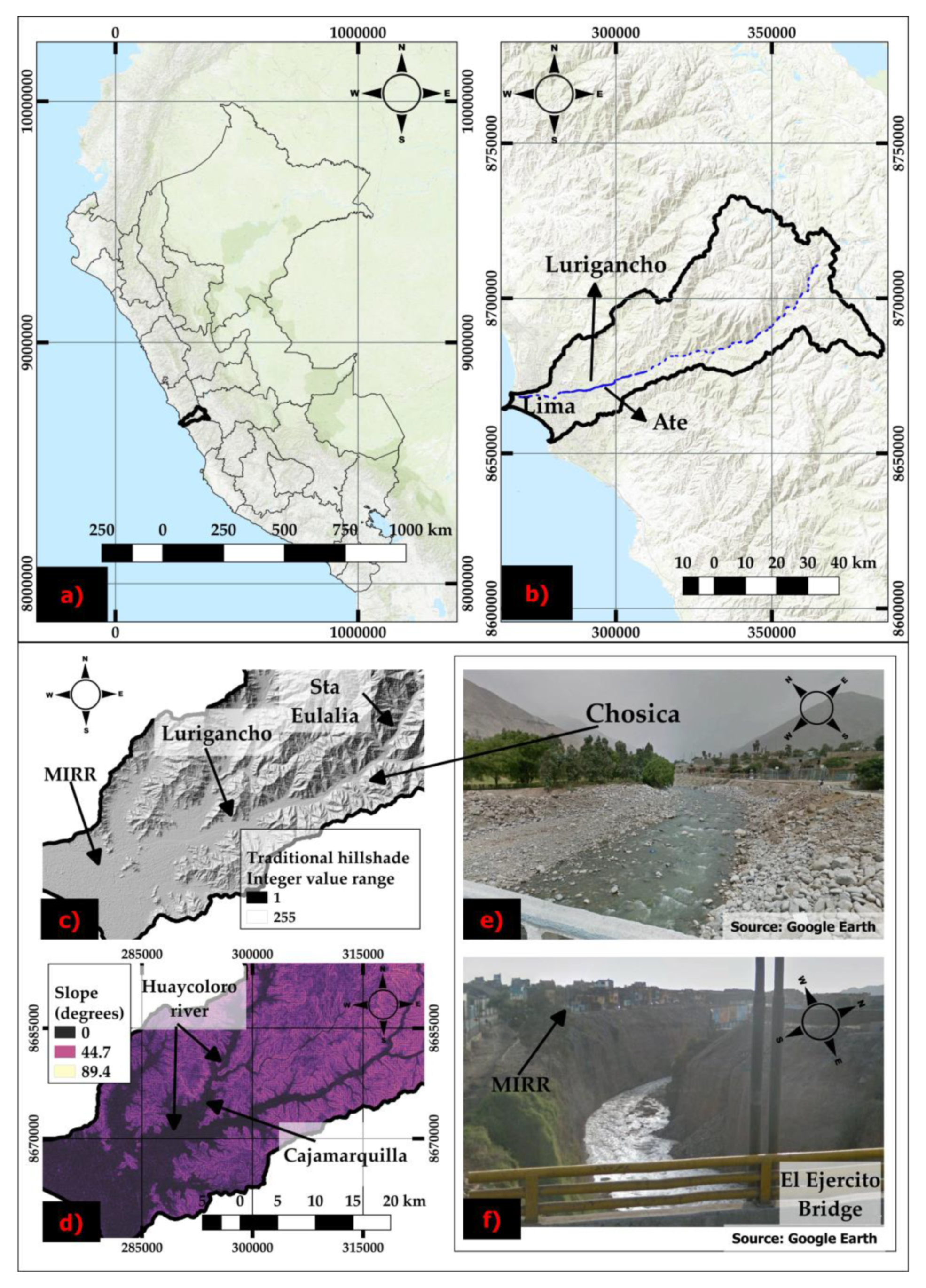

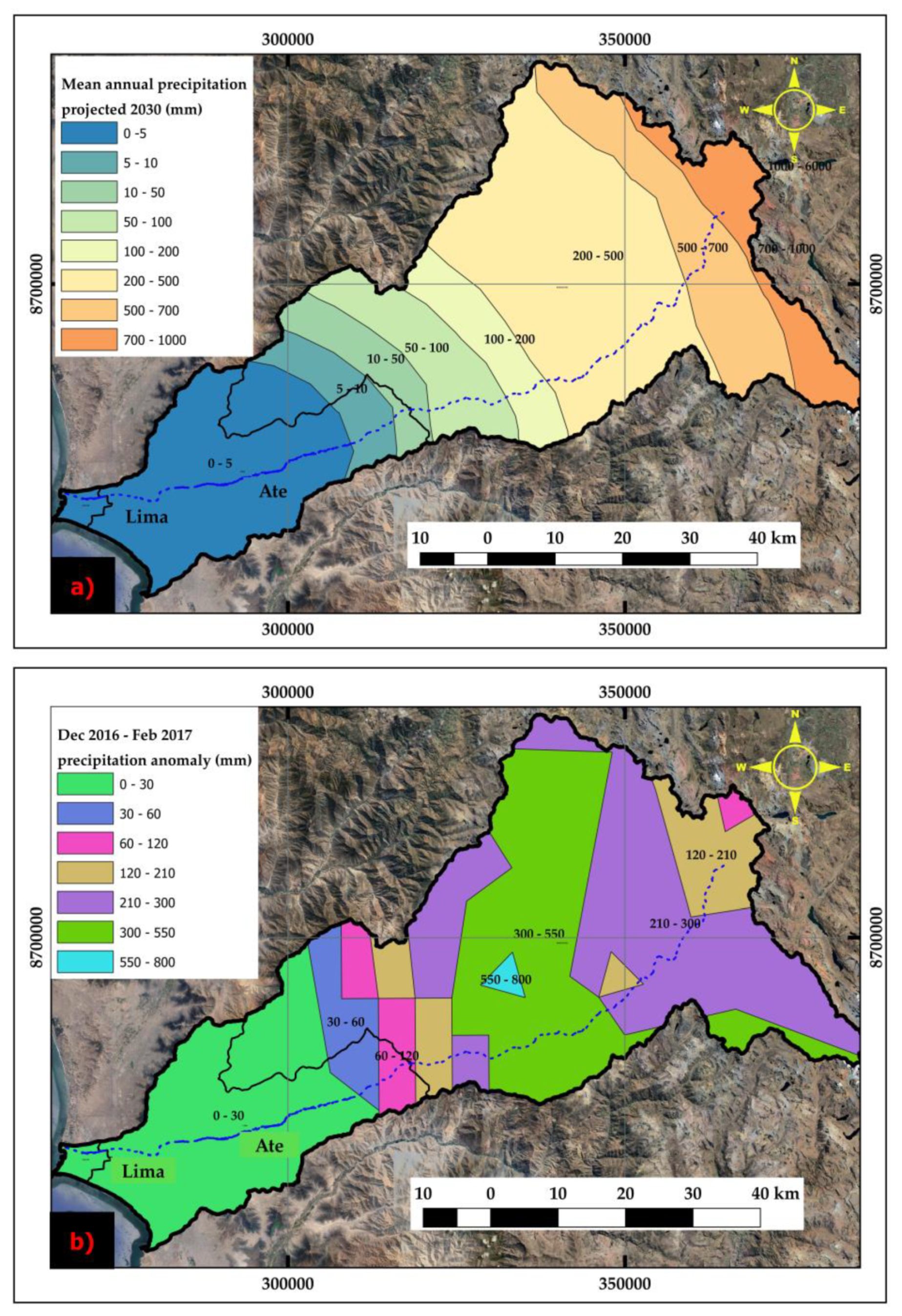


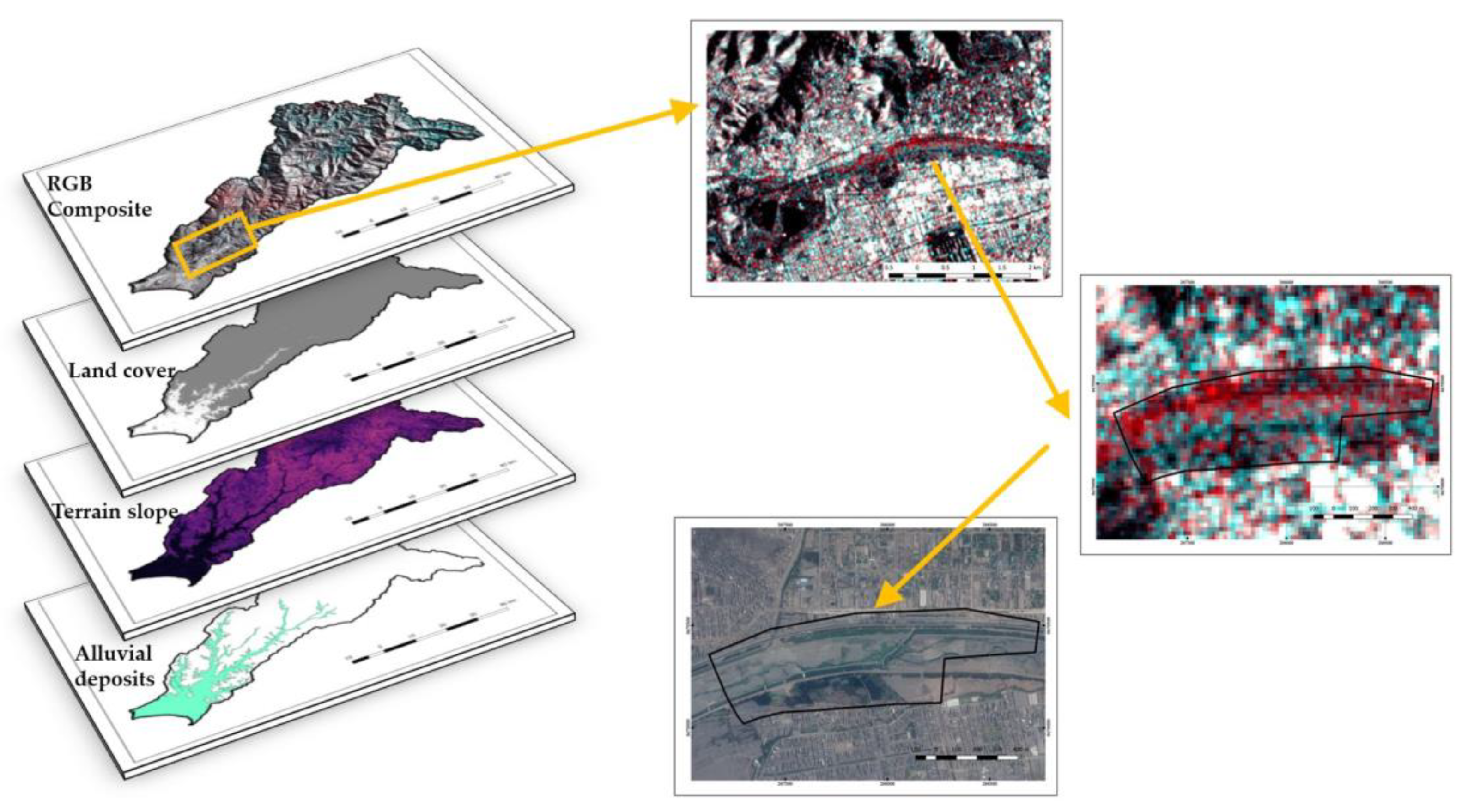
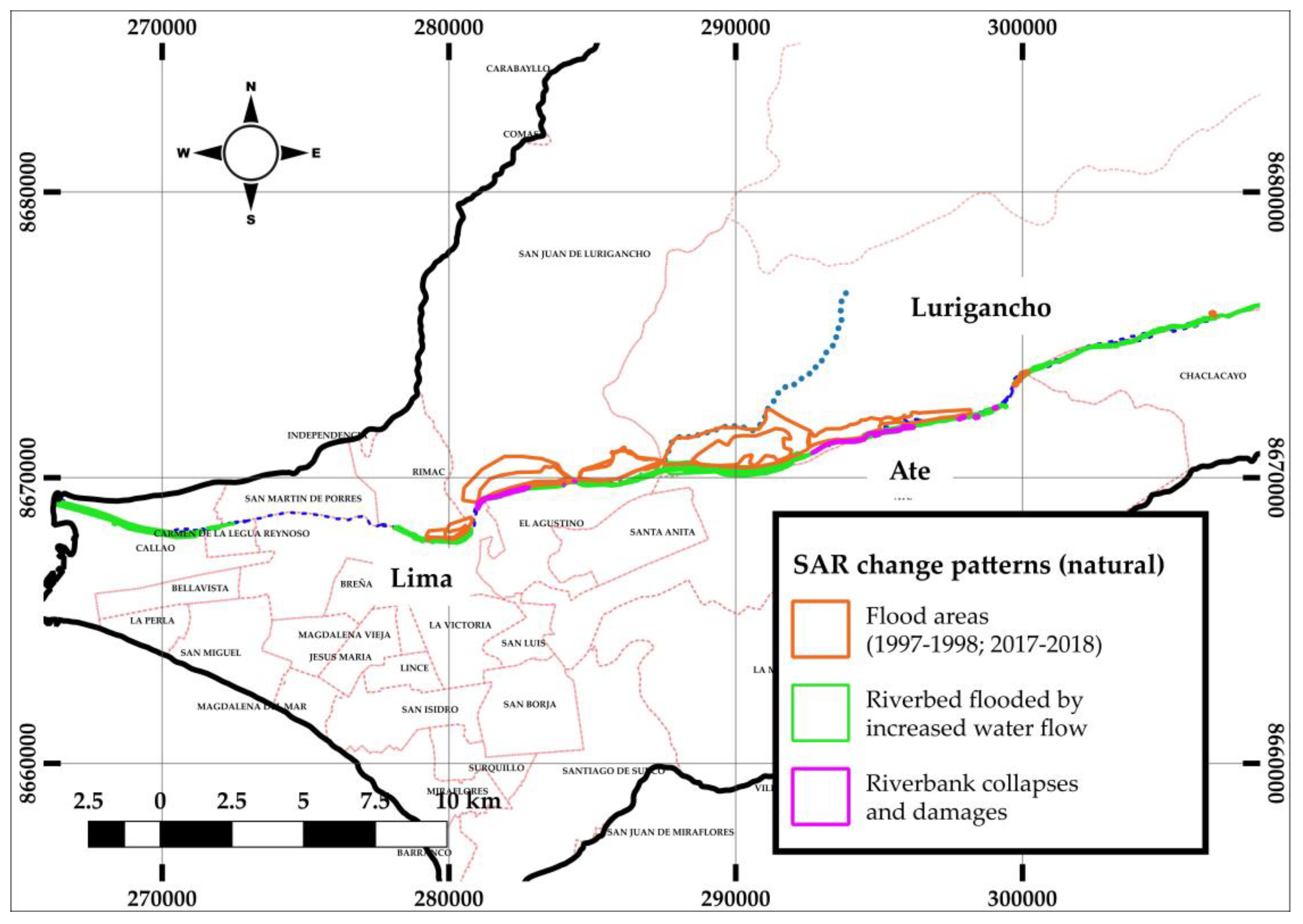
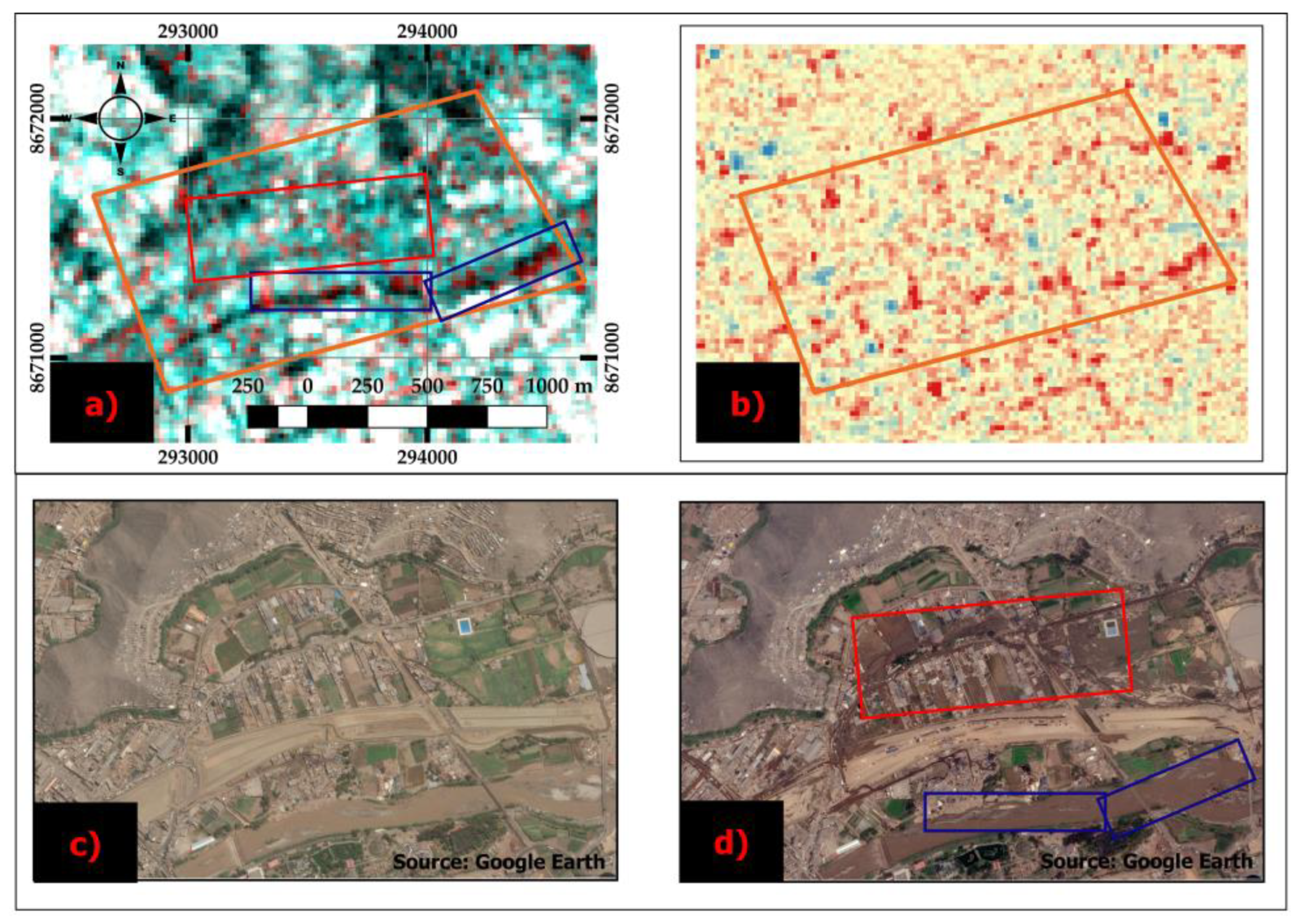

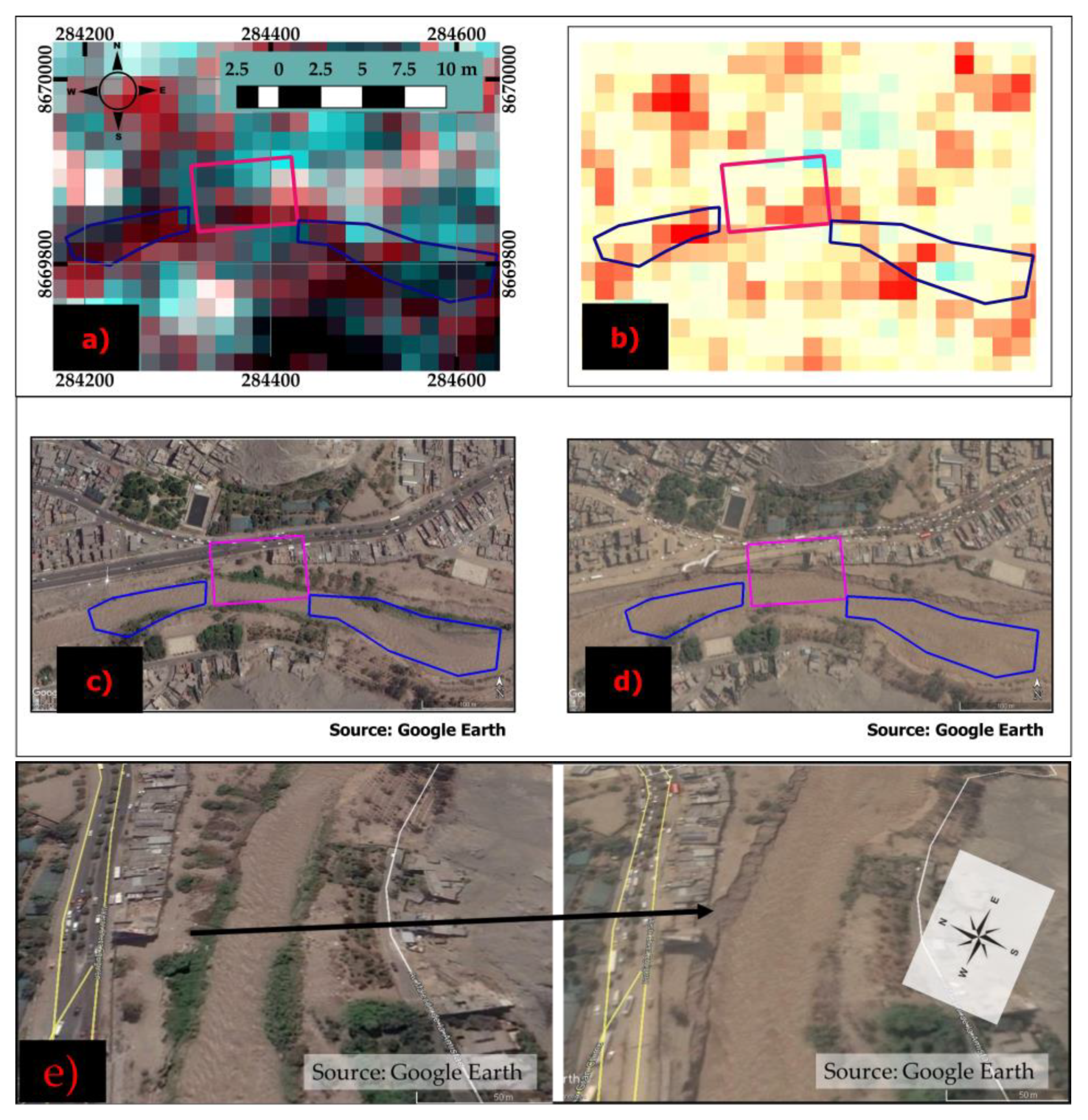
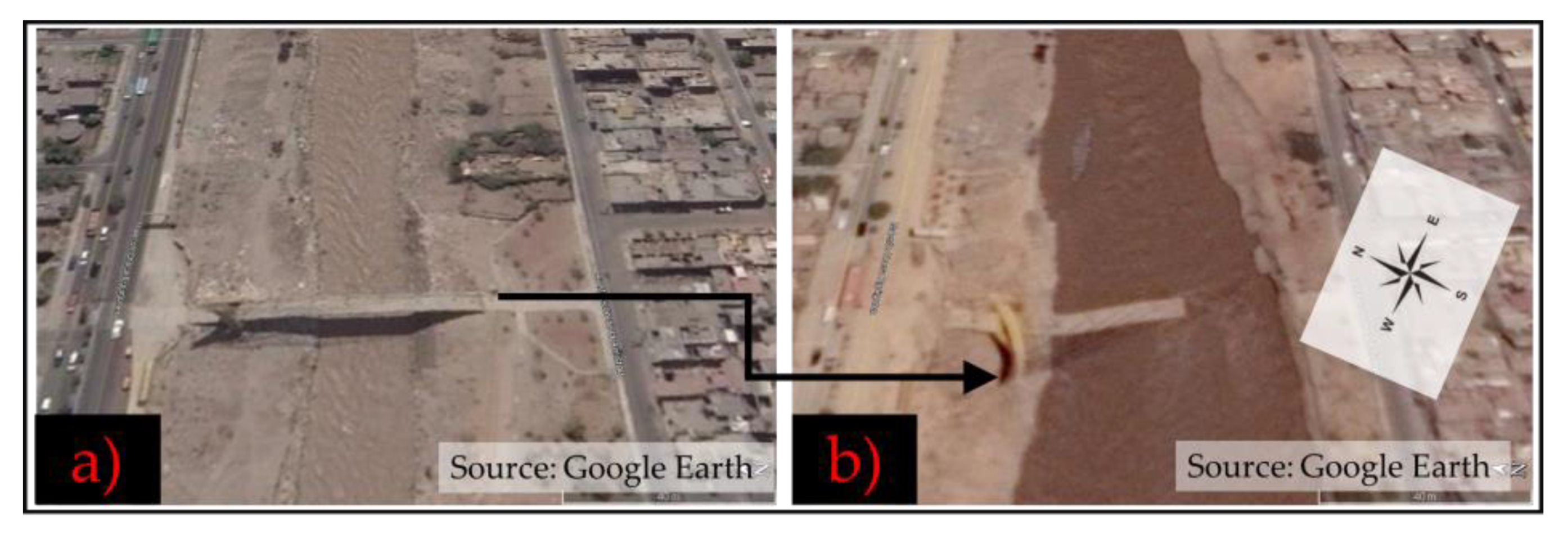
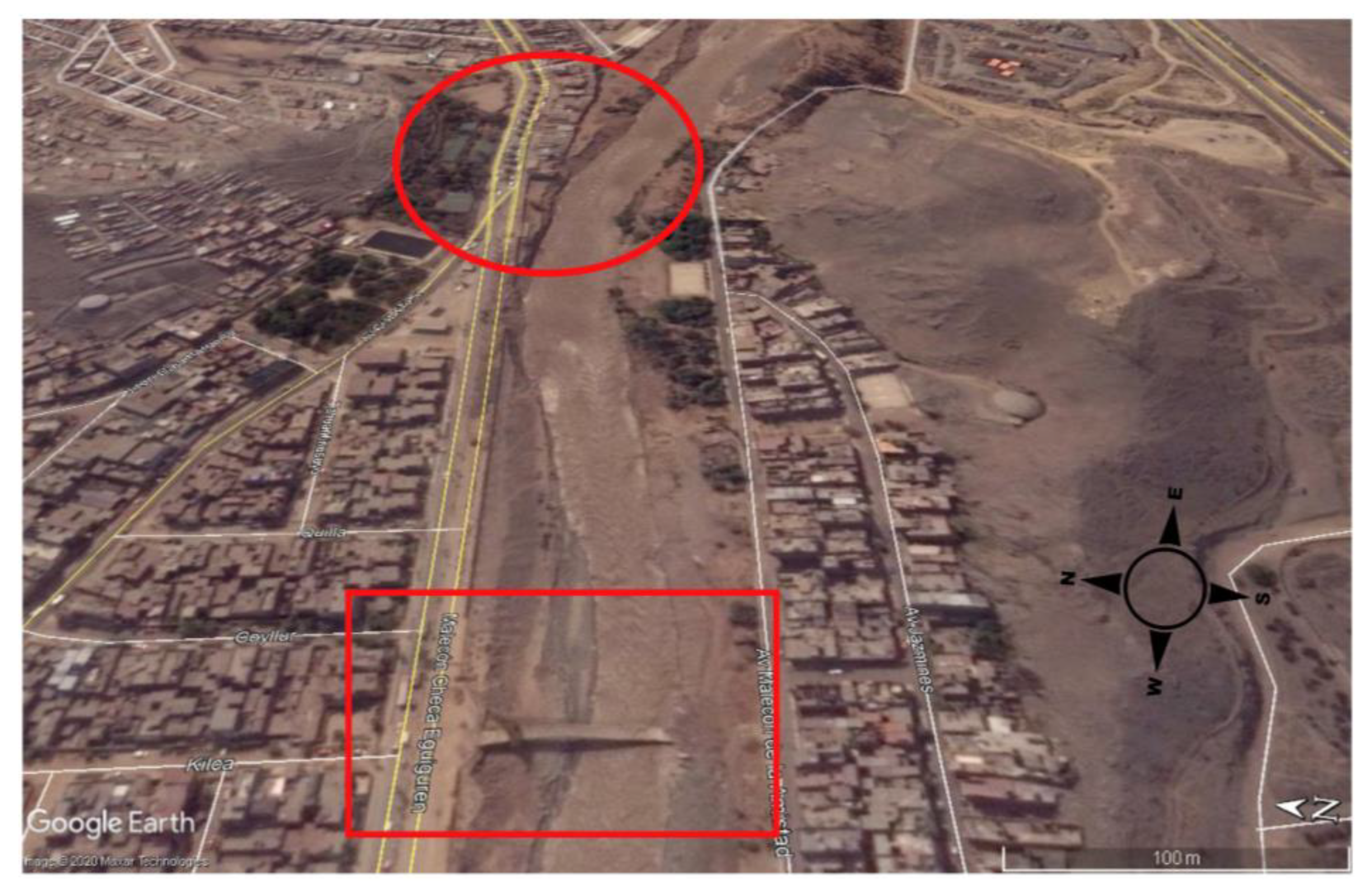
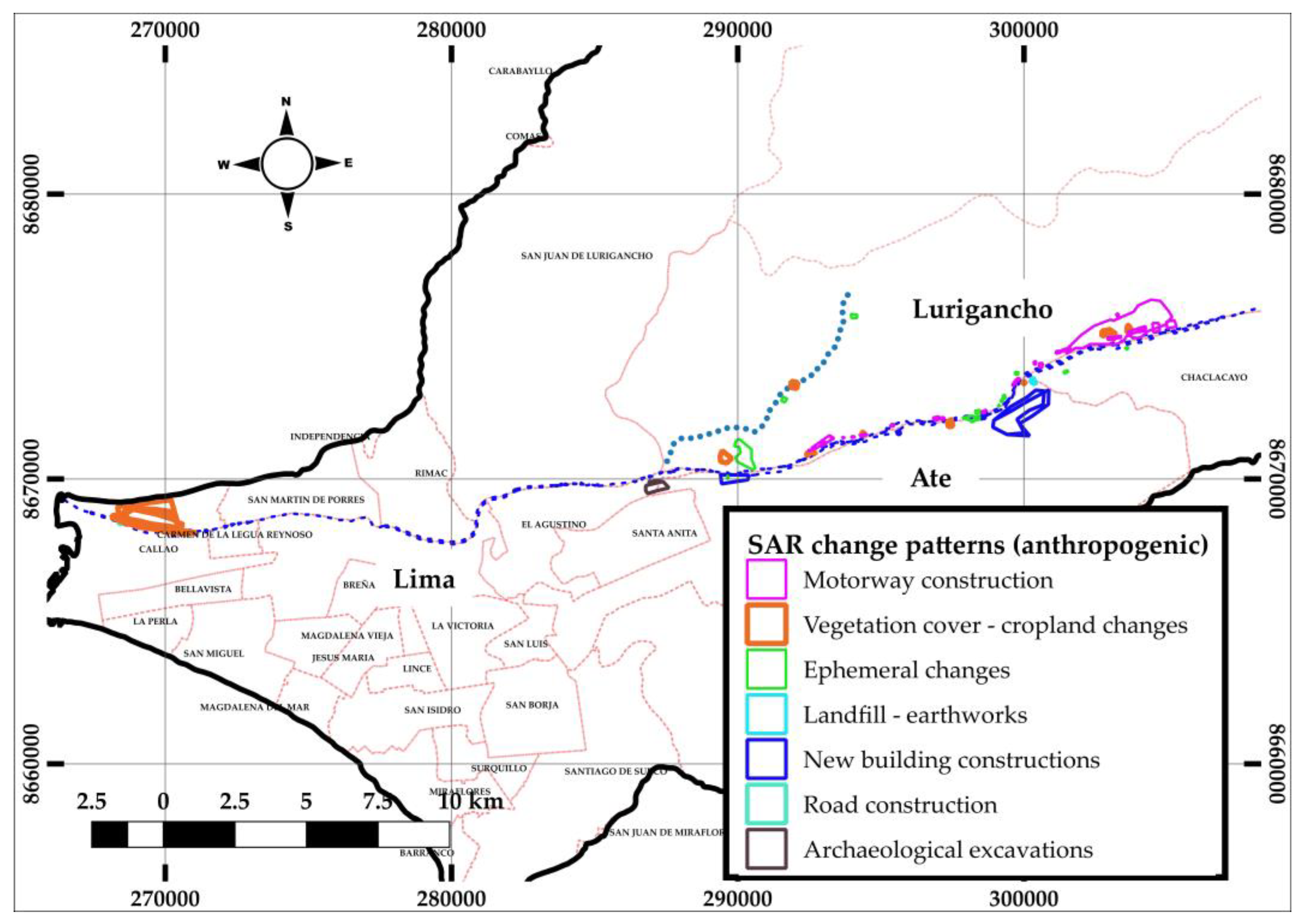
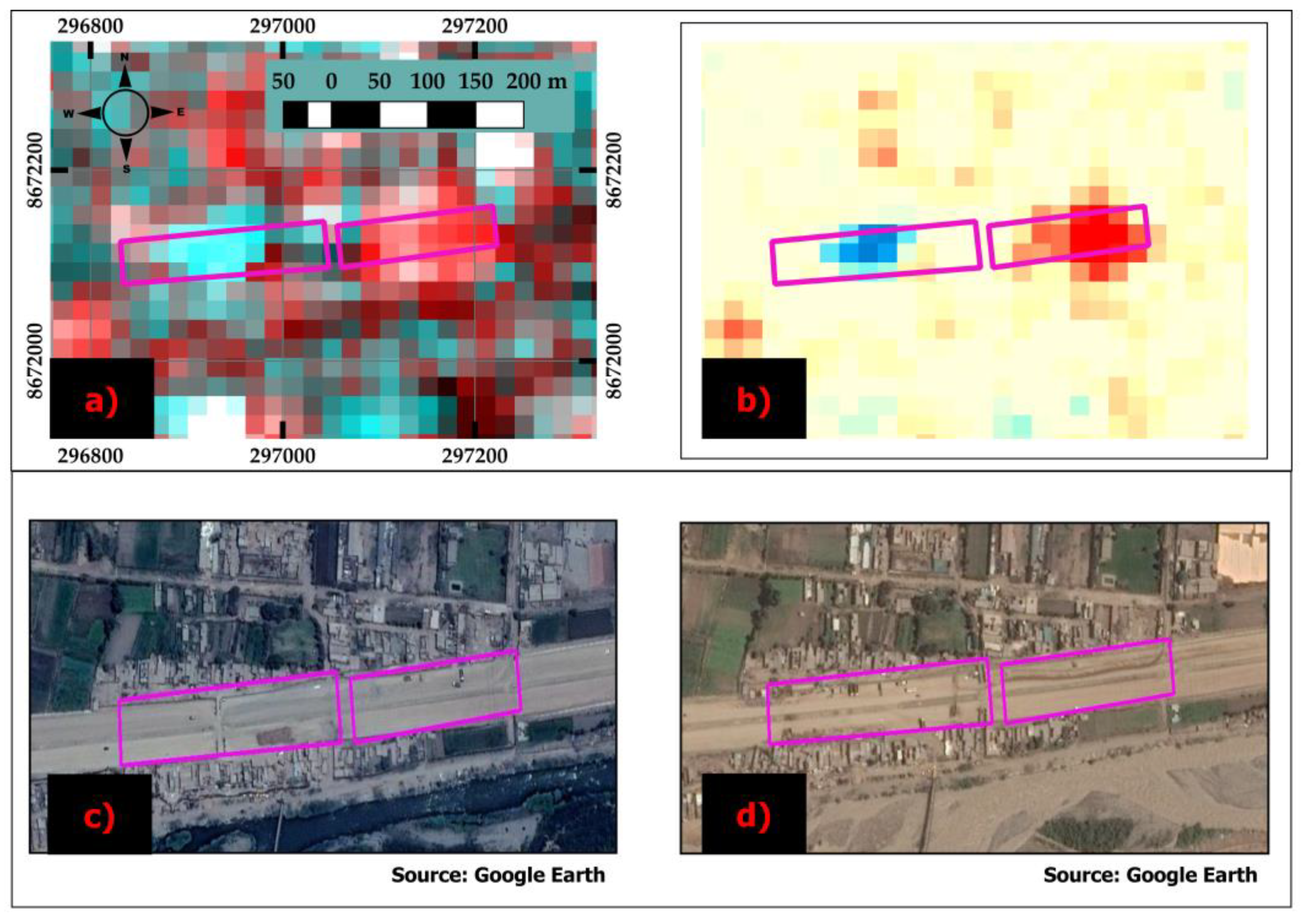
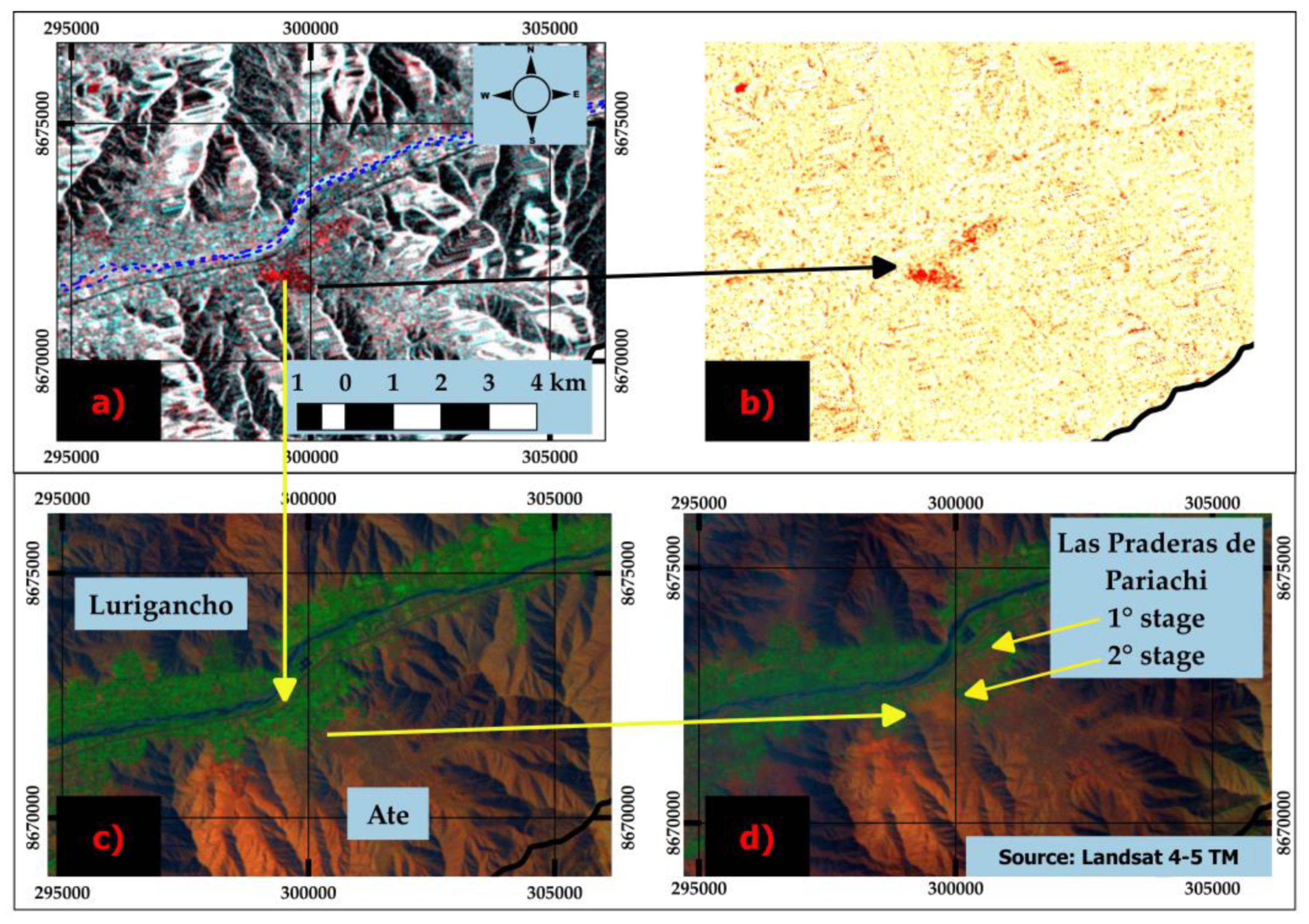
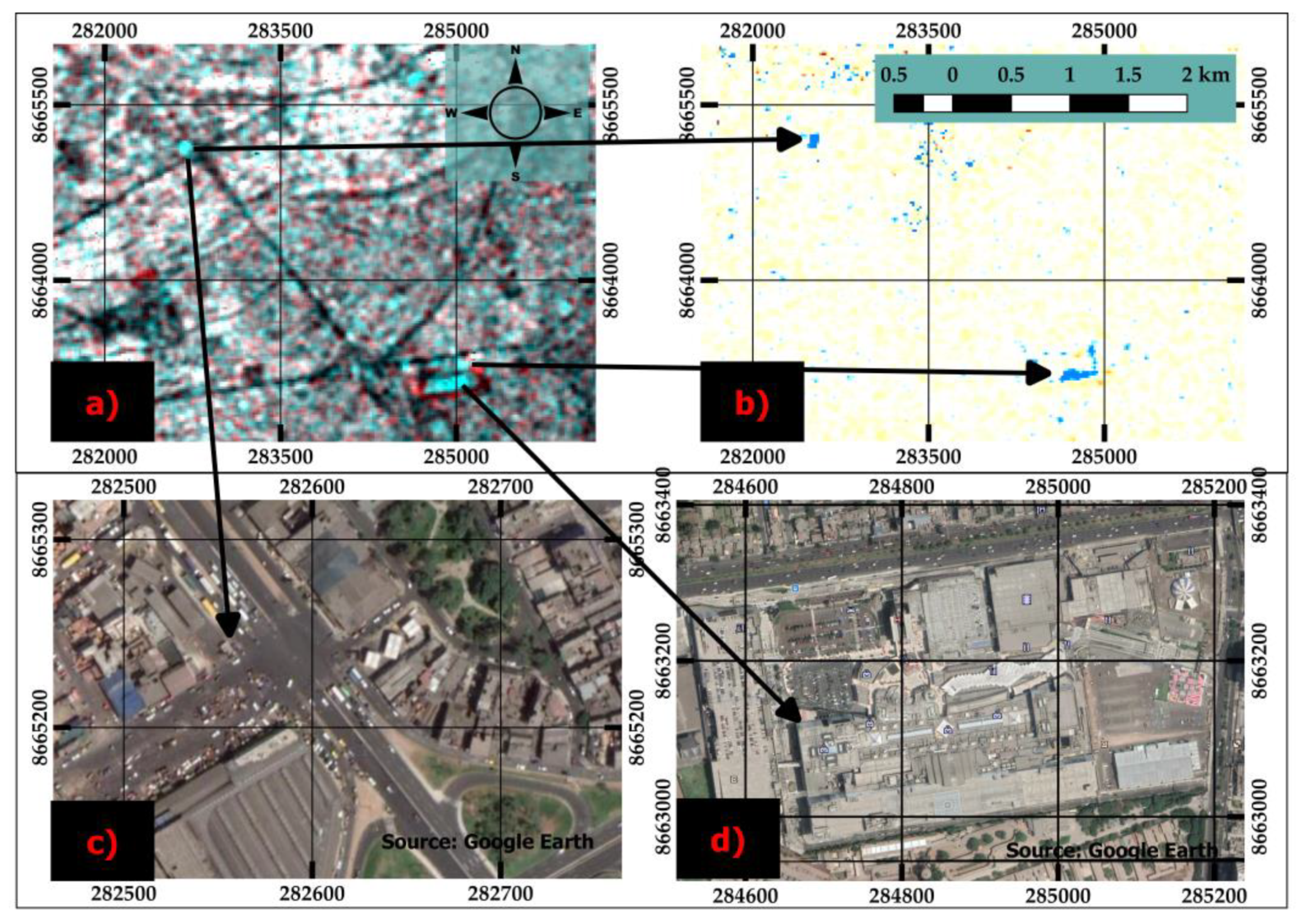
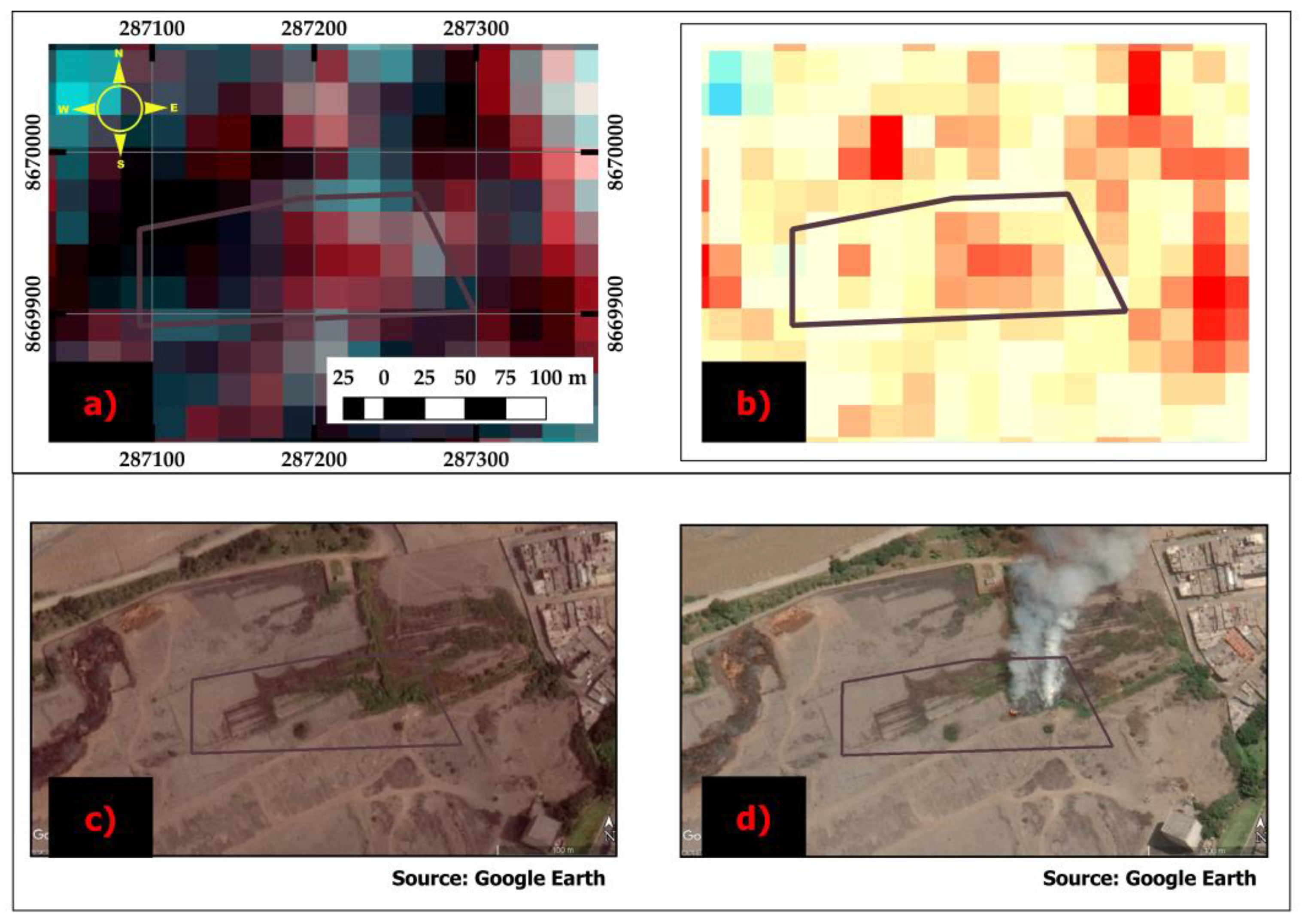
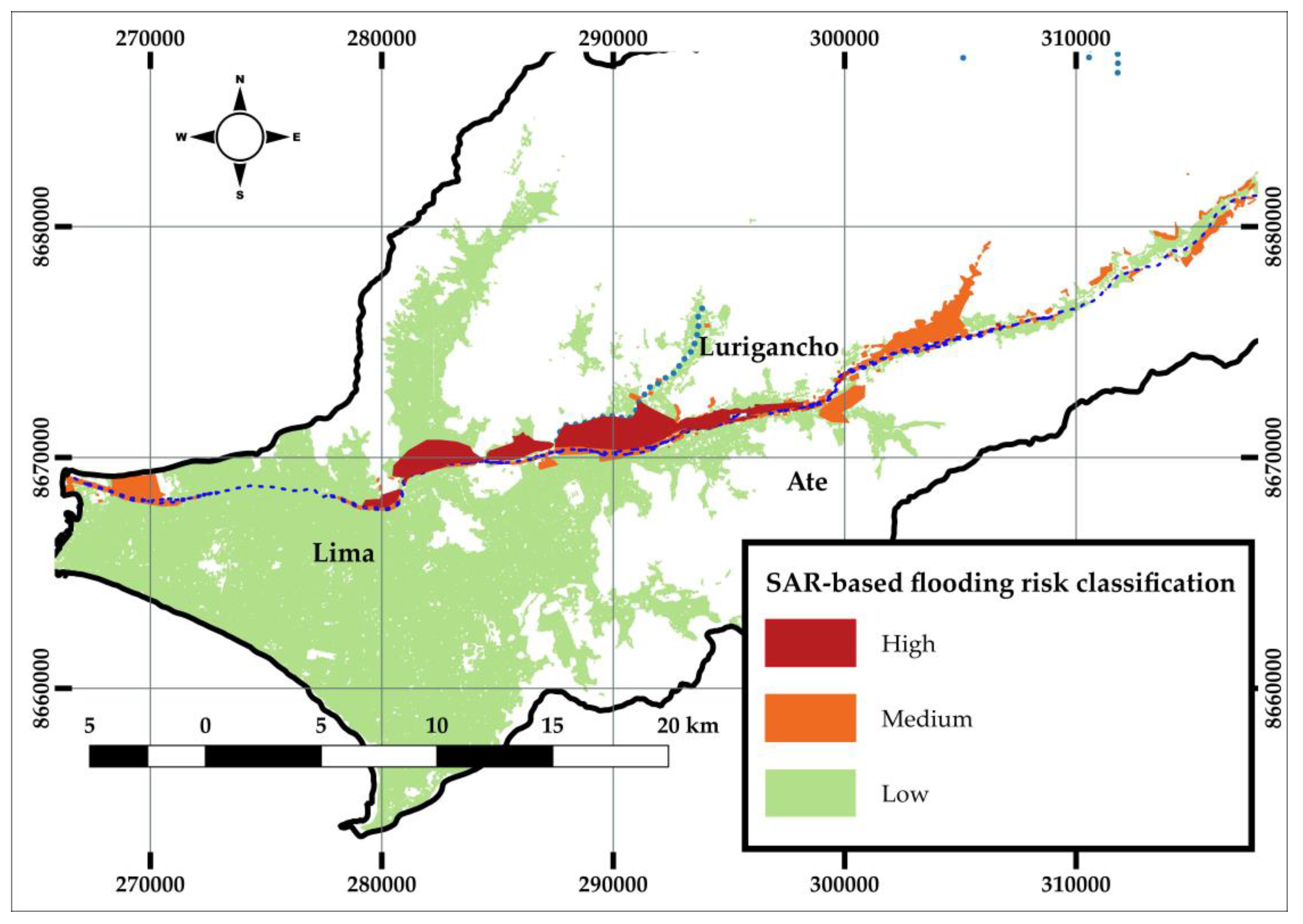
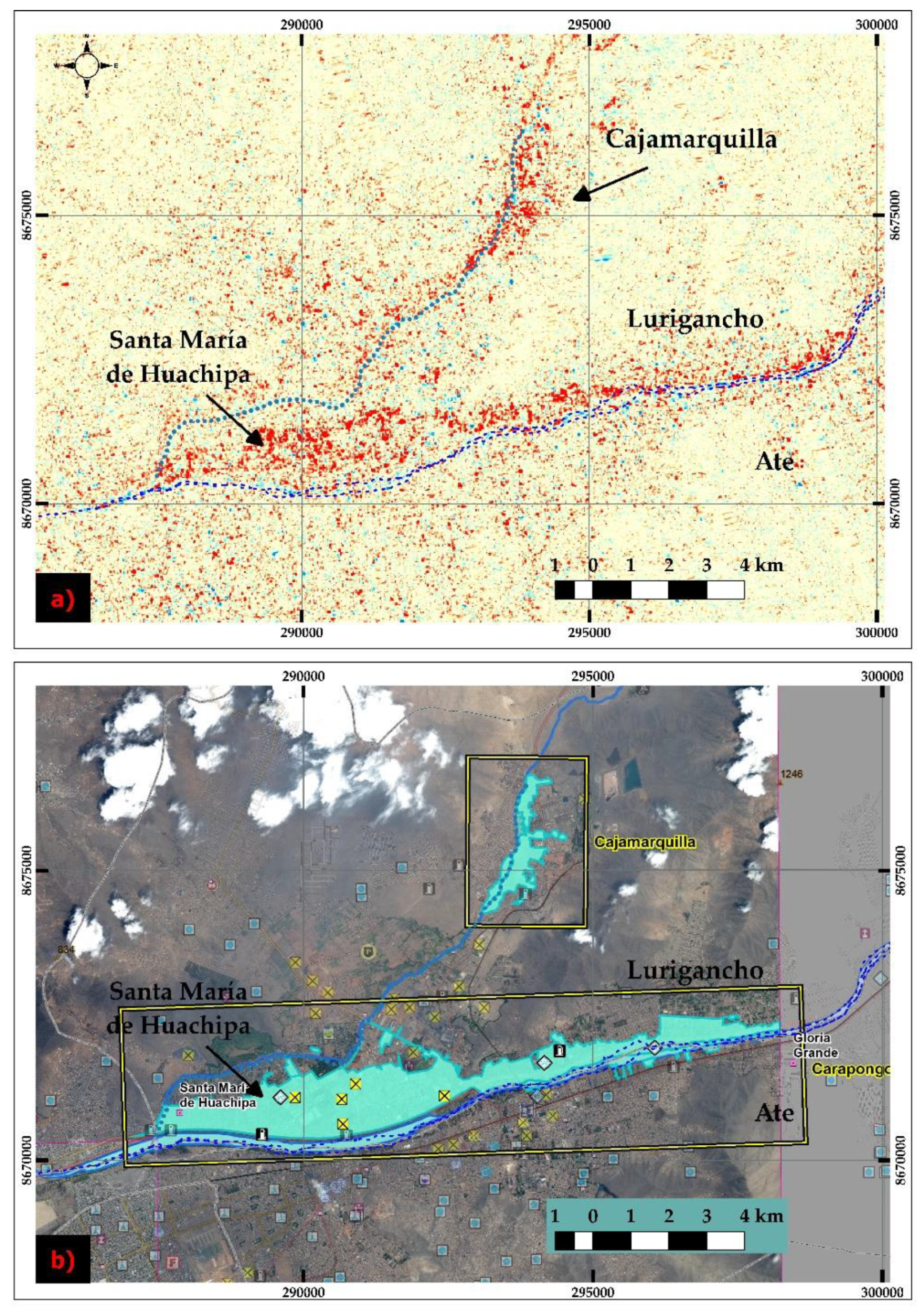
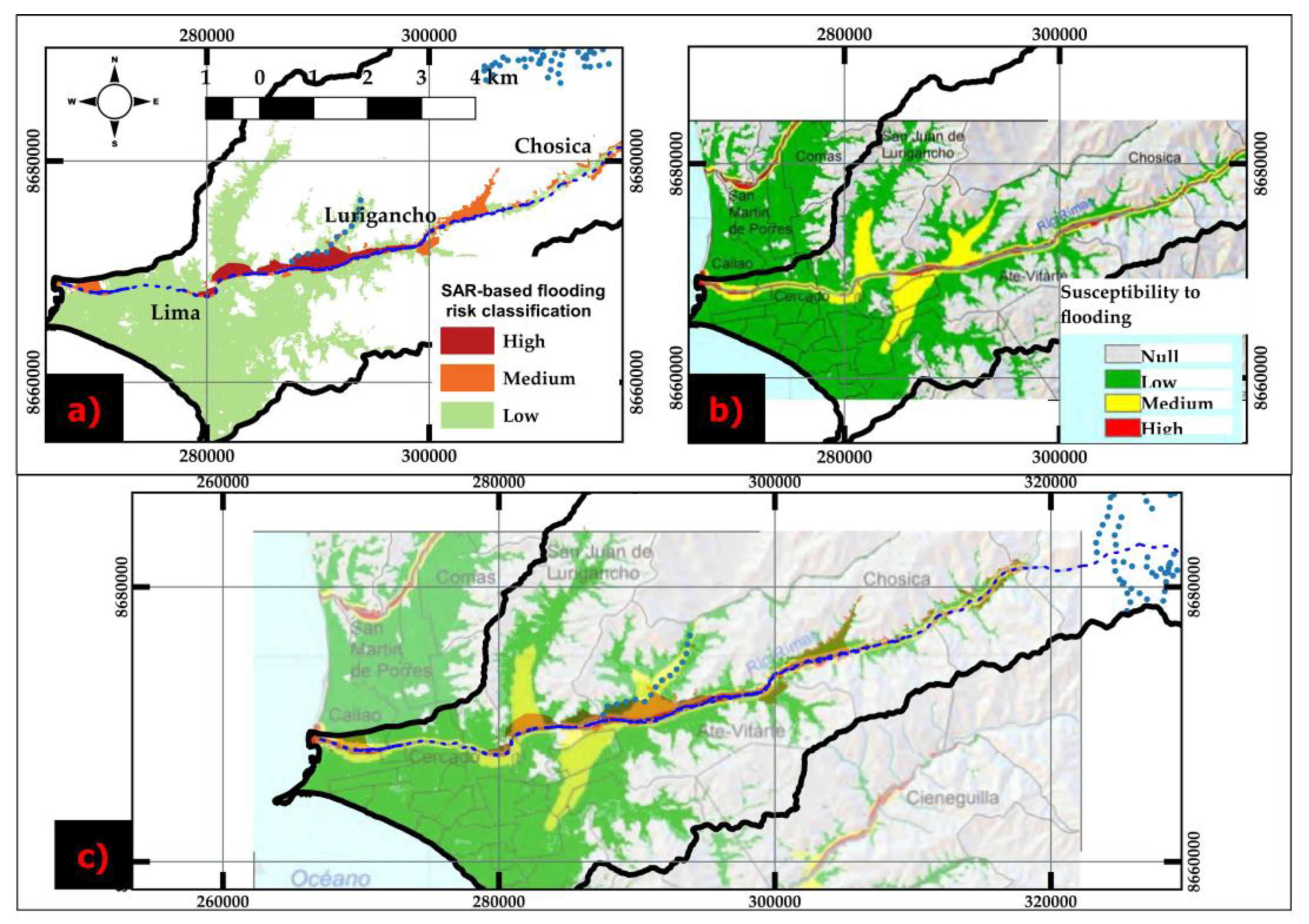
| Extraordinary Events | Number of Flood Events | Dates of Flooding in Urban Areas |
|---|---|---|
| 1982–1983 | Data n.a. | December 1982–June 1983 |
| 1997–1998 | 6 | 09/02/1998 23/02/1998 |
| 2017–2018 | 13 | 14/01/2017 31/01/2017 16/03/2017 14/02/2018 22/02/2018 |
| Satellite | Launch and End of Operations | Product Level | Revisit Time (Days) | Polarization | Mode | Band | Swath (km) | Ground Range Resolution (m) |
|---|---|---|---|---|---|---|---|---|
| ERS-1/2 | 1991/1995 2000/2011 | Level 1 SLC | 35 | VV | IM | C | 100 | 25 |
| Sentinel-1B | 2016 - | Level 1 GRD | 12 | VV+VH | IW | C | 250 | 5 (single look) |
| SAR Image Working Pairs | Pre-Event | Cross-Event | Post-Event | Total Number of SAR Working Pairs |
|---|---|---|---|---|
| 1997–1998 | 1 | 4 | 4 | 9 |
| 2017–2018 | 10 | 10 | 10 | 30 |
| Typology | Description | Format | Spatial Resolution and/or Scale | Reference Date | Source |
|---|---|---|---|---|---|
| Anthropogenic | Administrative boundaries | Shapefile | 1:100,000 | - | Geocatmin [72] |
| Census data (population/households) | Shapefile | 1:100,000 | 2011 | Geocatmin [73] | |
| Urban land cover | Raster | 12 m | 2011 | Global Urban Footprint [74,75] | |
| Open Street Map | Raster | - | - | QGIS desktop v.3.2.3 service | |
| Natural | Hydrographic basin | Shapefile | 1:175,000 | - | Ministerio del Ambiente-MINAM [76] |
| ASTER GDEM v.2 | Raster | 1 arcsec (30 m) | 2011 | USGS-NASA [77] | |
| Topographic contour lines | Shapefile | 1:100,000 | - | GEO_GSP_PERU [78] | |
| Geology | Shapefile | 1:100,000 | - | GEO_GSP_PERU [79] | |
| Global Surface Water | Web Map Service | - | 1984–2019 | EC JRC/Google [80,81] | |
| Basemap | Sentinel-2 image (cloud-free) | Raster | - | 2016 | Scihub |
| Google Earth basemap | Html (cache) | - | - | Google Earth |
| Category Code Flooding (F) | Description | Numbers of Changes | Area (km2) |
|---|---|---|---|
| Flooded areas (F1) | Areas that have been affected by the flood events in the years 1997–1998 and 2017–2018. | 15 | 18.90 |
| Riverbed flooded by increased water flow (F2) | Areas of the riverbed of the Rímac River which, due to an increase in its flow rate, have been submerged totally or partially. | 175 | 12.70 |
| Riverbank collapses and damage (F3) | Riverbed areas of the Rímac River (bordering the banks) which, as a consequence of the increase in its flow rate, have been totally or partially removed, causing damage to infrastructure or houses. | 7 | 0.50 |
| Category Code No Flooding (NF) | Description | Numbers of Changes | Area (km2) |
|---|---|---|---|
| Motorway construction (NF1) | Construction of the highway called “Nuova Autopista Centrale (NAC)” (New Central Highway) | 37 | 3.30 |
| Vegetation cover–cropland changes (NF2) | Increase or decrease in vegetation cover (sowing/harvesting). Also included cultivated areas that have suffered a variation in land use | 27 (18) | 5.50 |
| Ephemeral changes (NF3) | Parked vehicles (e.g., trucks, goods loading/unloading activities). They are located near the sales companies or factories of different types of products | 15 | 0.60 |
| NF4 | Machinery sales areas | 2 | 0.30 |
| NF5 | Vehicle traffic | 45 | 2.90 |
| NF6 | Raising water content in the treatment tanks. These changes have been identified in the water/waste treatment plants | 9 | 0.70 |
| Landfill-earthworks (NF7) | Soil deposit, to prepare the area for a change in land use | 7 (2) | 0.20 |
| NF8 | Soil movement, identified as quarry zones | 22 | 1.80 |
| New building constructions (NF9) | New construction areas (sheds/new urban areas) | 26 (5) | 8.40 |
| NF10 | Warehouse areas | 10 | 2.30 |
| NF11 | Cemetery area | 1 | 0.01 |
| Road construction (NF12) | Roads under construction (Moralez duarez/Lurigancho/Gambetta) | 7 (1) | 0.18 |
| Archaeological excavations (NF13) | Archaeological remains | 4 | 0.20 |
| Type of Change | Slope (Class) | Alluvial Deposits | Urban | Non-Urban |
|---|---|---|---|---|
| F1 | B-D | ✓ | ✓ | |
| F2 | A-B | ✓ | ✓ | |
| F3 | A-B | ✓ | ✓ | |
| NF1 | A | ✓ | ✓ | |
| NF2 | A | ✓ | ✓ | |
| NF3 | A-B | ✓ | ✓ | ✓ |
| NF7 | B | ✓ | ✓ | |
| NF9 | A | ✓ | ✓ | |
| NF12 | A | ✓ | ✓ | |
| NF13 | A | ✓ | ✓ |
© 2020 by the authors. Licensee MDPI, Basel, Switzerland. This article is an open access article distributed under the terms and conditions of the Creative Commons Attribution (CC BY) license (http://creativecommons.org/licenses/by/4.0/).
Share and Cite
Alvan Romero, N.; Cigna, F.; Tapete, D. ERS-1/2 and Sentinel-1 SAR Data Mining for Flood Hazard and Risk Assessment in Lima, Peru. Appl. Sci. 2020, 10, 6598. https://doi.org/10.3390/app10186598
Alvan Romero N, Cigna F, Tapete D. ERS-1/2 and Sentinel-1 SAR Data Mining for Flood Hazard and Risk Assessment in Lima, Peru. Applied Sciences. 2020; 10(18):6598. https://doi.org/10.3390/app10186598
Chicago/Turabian StyleAlvan Romero, Nancy, Francesca Cigna, and Deodato Tapete. 2020. "ERS-1/2 and Sentinel-1 SAR Data Mining for Flood Hazard and Risk Assessment in Lima, Peru" Applied Sciences 10, no. 18: 6598. https://doi.org/10.3390/app10186598
APA StyleAlvan Romero, N., Cigna, F., & Tapete, D. (2020). ERS-1/2 and Sentinel-1 SAR Data Mining for Flood Hazard and Risk Assessment in Lima, Peru. Applied Sciences, 10(18), 6598. https://doi.org/10.3390/app10186598







